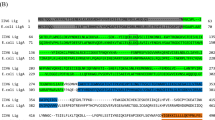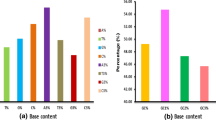Abstract
In the present study, we examined the codon usage bias between pseudorabies virus (PRV) US1 gene and the US1-like genes of 20 reference alphaherpesviruses. Comparative analysis showed noticeable disparities of the synonymous codon usage bias in the 21 alphaherpesviruses, indicated by codon adaptation index, effective number of codons (ENc) and GC3s value. The codon usage pattern of PRV US1 gene was phylogenetically conserved and similar to that of the US1-like genes of the genus Varicellovirus of alphaherpesvirus, with a strong bias towards the codons with C and G at the third codon position. Cluster analysis of codon usage pattern of PRV US1 gene with its reference alphaherpesviruses demonstrated that the codon usage bias of US1-like genes of 21 alphaherpesviruses had a very close relation with their gene functions. ENc-plot revealed that the genetic heterogeneity in PRV US1 gene and the 20 reference alphaherpesviruses was constrained by G+C content, as well as the gene length. In addition, comparison of codon preferences in the US1 gene of PRV with those of E. coli, yeast and human revealed that there were 50 codons showing distinct usage differences between PRV and yeast, 49 between PRV and human, but 48 between PRV and E. coli. Although there were slightly fewer differences in codon usages between E.coli and PRV, the difference is unlikely to be statistically significant, and experimental studies are necessary to establish the most suitable expression system for PRV US1. In conclusion, these results may improve our understanding of the evolution, pathogenesis and functional studies of PRV, as well as contributing to the area of herpesvirus research or even studies with other viruses.
Similar content being viewed by others
References
Advani S J, Weichselbaum R R, Roizman B. 2003. Herpes simplex virus 1 activates cdc2 to recruit topoisomerase II alpha for post-DNA synthesis expression of late genes. Proc Natl Acad Sci U S A, 100:4825–4830.
Ambagala A P, Cohen J I. 2007. Varicella-Zoster virus IE63, a major viral latency protein, is required to inhibit the alpha interferon-induced antiviral response. J Virol, 81:7844–7851.
Bastian T W, Livingston C M, Weller S K, et al. 2010. Herpes simplex virus type 1 immediate-early protein ICP22 is required for VICE domain formation during productive viral infection. J Virol, 84:2384–2394.
Bernardi G. 1986. Compositional constraints and genome evolution. J Mol Evol, 24:1–11.
Blaisdell B E. 1983. Choice of base at silent codon site 3 is not selectively neutral in eucaryotic structural genes: it maintains excess short runs of weak and strong hydrogen bonding bases. J Mol Evol, 19:226–236.
Blake R D, Hinds P W. 1984. Analysis of the codon bias in E. coli sequences. J Biomol Struct Dyn, 2:593–606.
Boelaert F, Deluyker H, Maes D, et al. 1999. Prevalence of herds with young sows seropositive to pseudorabies (Aujeszky’s disease) in northern Belgium. Prev Vet Med, 41:239–255.
Bowman J J, Orlando J S, Davido D J, et al. 2009. Transient expression of herpes simplex virus type 1 ICP22 represses viral promoter activity and complements the replication of an ICP22 null virus. J Virol, 83:8733–8743.
Burland T G. 2000. DNASTAR’s Lasergene sequence analysis software. Methods Mol Biol, 132:71–91.
Cai M S, Cheng A C, Wang M S, et al. 2009. Characterization of synonymous codon usage bias in the duck plague virus UL35 gene. Intervirology, 52:266–278.
Cohen J I, Cox E, Pesnicak L, et al. 2004. The varicella-zoster virus open reading frame 63 latency-associated protein is critical for establishment of latency. J Virol, 78:11833–11840.
Cohen J I, Krogmann T, Bontems S, et al. 2005. Regions of the varicella-zoster virus open reading frame 63 latency-associated protein important for replication in vitro are also critical for efficient establishment of latency. J Virol, 79:5069–5077.
Comeron J M, Aguade M. 1998. An evaluation of measures of synonymous codon usage bias. J Mol Evol, 47:268–274.
D’Onofrio G, Ghosh T C, Bernardi G. 2002. The base composition of the genes is correlated with the secondary structures of the encoded proteins. Gene, 300:179–187.
Dass J F, Sudandiradoss C. 2012. Insight into pattern of codon biasness and nucleotide base usage in serotonin receptor gene family from different mammalian species. Gene, 503:92–100.
Durand L O, Roizman B. 2008. Role of cdk9 in the optimization of expression of the genes regulated by ICP22 of herpes simplex virus 1. J Virol, 82:10591–10599.
Duret L. 2002. Evolution of synonymous codon usage in metazoans. Curr Opin Genet Dev, 12:640–649.
Fu M. 2010. Codon usage bias in herpesvirus. Arch Virol, 155:391–396.
Gouy M, Gautier C. 1982. Codon usage in bacteria: correlation with gene expressivity. Nucleic Acids Res, 10:7055–7074.
Grantham R, Gautier C, Gouy M, et al. 1981. Codon catalog usage is a genome strategy modulated for gene expressivity. Nucleic Acids Res, 9:r43–r74.
Grantham R, Gautier C, Gouy M, et al. 1980. Codon catalog usage and the genome hypothesis. Nucleic Acids Res, 8:r49–r62.
Grosjean H, Fiers W. 1982. Preferential codon usage in prokaryotic genes: the optimal codon-anticodon interaction energy and the selective codon usage in efficiently expressed genes. Gene, 18:199–209.
Gupta S K, Ghosh T C. 2001. Gene expressivity is the main factor in dictating the codon usage variation among the genes in Pseudomonas aeruginosa. Gene, 273:63–70.
Hooper S D, Berg O G. 2000. Gradients in nucleotide and codon usage along Escherichia coli genes. Nucleic Acids Res, 28:3517–3523.
Hou Z C, Yang N. 2003. Factors affecting codon usage in Yersinia pestis. Acta Bioch Bioph Sin, 35:580–586.
Ikemura T. 1985. Codon usage and tRNA content in unicellular and multicellular organisms. Mol Biol Evol, 2:13–34.
Ikemura T. 1981. Correlation between the abundance of Escherichia coli transfer RNAs and the occurrence of the respective codons in its protein genes: a proposal for a synonymous codon choice that is optimal for the E. coli translational system. J Mol Biol, 151:389–409.
Jia R, Cheng A, Wang M, et al. 2009. Analysis of synonymous codon usage in the UL24 gene of duck enteritis virus. Virus Genes, 38:96–103.
Jiang P, Sun X, Lu Z. 2007. Analysis of synonymous codon usage in Aeropyrum pernix K1 and other Crenarchaeota microorganisms. J Genet Genomics, 34:275–284.
Jones J O, Arvin A M. 2005. Viral and cellular gene transcription in fibroblasts infected with small plaque mutants of varicella-zoster virus. Antiviral Res, 68:56–65.
Kalamvoki M, Roizman B. 2011. The histone acetyltransferase CLOCK is an essential component of the herpes simplex virus 1 transcriptome that includes TFIID, ICP4, ICP27, and ICP22. J Virol, 85:9472–9477.
Koppers-Lalic D, Reits E A, Ressing M E, et al. 2005. Varicelloviruses avoid T cell recognition by UL49.5-mediated inactivation of the transporter associated with antigen processing. Proc Natl Acad Sci U S A, 102:5144–5149.
Kost R G, Kupinsky H, Straus S E. 1995. Varicella-zoster virus gene 63: transcript mapping and regulatory activity. Virology, 209:218–224.
Li M L, Wang S, Cai M S, et al. 2011. Characterization of molecular determinants for nucleocytoplasmic shuttling of PRV UL54. Virology, 417:385–393.
Li M L, Wang S, Cai M S, et al. 2011. Identification of nuclear and nucleolar localization signals of pseudorabies virus (PRV) early protein UL54 reveals that its nuclear targeting is required for efficient production of PRV. J Virol, 85:10239–10251.
Liu Q, Dou S, Ji Z, et al. 2005. Synonymous codon usage and gene function are strongly related in Oryza sativa. Biosystems, 80:123–131.
Lobry J R, Gautier C. 1994. Hydrophobicity, expressivity and aromaticity are the major trends of amino-acid usage in 999 Escherichia coli chromosome-encoded genes. Nucleic Acids Res, 22:3174–3180.
Lu H, Zhao W M, Zheng Y, et al. 2005. Analysis of synonymous codon usage bias in Chlamydia. Acta Biochim Biophys Sin, 37:1–10.
Maruyama T, Gojobori T, Aota S, et al. 1986. Codon usage tabulated from the GenBank genetic sequence data. Nucleic Acids Res, 14 Suppl:r151–197.
Moriyama E N, Powell J R. 1998. Gene length and codon usage bias in Drosophila melanogaster, Saccharomyces cerevisiae and Escherichia coli. Nucleic Acids Res, 26:3188–3193.
Mueller N H, Walters M S, Marcus R A, et al. 2010. Identification of phosphorylated residues on varicella-zoster virus immediate-early protein ORF63. J Gen Virol, 91:1133–1137.
Muller T, Batza H J, Schluter H, et al. 2003. Eradication of Aujeszky’s disease in Germany. J Vet Med B Infect Dis Vet Public Health, 50:207–213.
Muller T, Hahn E C, Tottewitz F, et al. 2011. Pseudorabies virus in wild swine: a global perspective. Arch Virol, 156:1691–1705.
Najafabadi H S, Goodarzi H, Salavati R. 2009. Universal function-specificity of codon usage. Nucleic Acids Res, 37:7014–7023.
Novembre J A. 2002. Accounting for background nucleotide composition when measuring codon usage bias. Mol Biol Evol, 19:1390–1394.
Ono E, Amagai K, Yoshino S, et al. 2004. Resistance to pseudorabies virus infection in transformed cell lines expressing a soluble form of porcine herpesvirus entry mediator C. J Gen Virol, 85:173–178.
Orlando J S, Balliet J W, Kushnir A S, et al. 2006. ICP22 is required for wild-type composition and infectivity of herpes simplex virus type 1 virions. J Virol, 80:9381–9390.
Pomeranz L E, Reynolds A E, Hengartner C J. 2005. Molecular biology of pseudorabies virus: impact on neurovirology and veterinary medicine. Microbiol Mol Biol Rev, 69:462–500.
Roychoudhury S, Mukherjee D. 2010. A detailed comparative analysis on the overall codon usage pattern in herpesviruses. Virus Res, 148:31–43.
Sharp P M, Averof M, Lloyd A T, et al. 1995. DNA sequence evolution: the sounds of silence. Philos Trans R Soc Lond B Biol Sci, 349:241–247.
Sharp P M, Li W H. 1987. The codon Adaptation Index—a measure of directional synonymous codon usage bias, and its potential applications. Nucleic Acids Res, 15:1281–1295.
Wada A, Suyama A. 1986. Local stability of DNA and RNA secondary structure and its relation to biological functions. Prog Biophys Mol Biol, 47:113–157.
Wain-Hobson S, Nussinov R, Brown R J, et al. 1981. Preferential codon usage in genes. Gene, 13:355–364.
Weinstein J N, Myers T G, O’Connor P M, et al. 1997. An information-intensive approach to the molecular pharmacology of cancer. Science, 275:343–349.
White A K, Ciacci-Zanella J, Galeota J, et al. 1996. Comparison of the abilities of serologic tests to detect pseudorabies-infected pigs during the latent phase of infection. Am J Vet Res, 57:608–611.
Wright F. 1990. The ‘effective number of codons’ used in a gene. Gene, 87:23–29.
Author information
Authors and Affiliations
Corresponding author
Additional information
Foundation items: This work was supported by grants from the Scientific Research Foundation for the Ph.D., Guangzhou Medical University (2011C20); National Natural Science Foundation of China (31200120); Medical Scientific Research Foundation of Guangdong Province, China (B2012165), and the Guangzhou city-level key disciplines and specialties of Immunology (B127007).
Rights and permissions
About this article
Cite this article
Li, M., Zhao, Z., Chen, J. et al. Characterization of synonymous codon usage bias in the pseudorabies virus US1 gene. Virol. Sin. 27, 303–315 (2012). https://doi.org/10.1007/s12250-012-3270-9
Received:
Accepted:
Published:
Issue Date:
DOI: https://doi.org/10.1007/s12250-012-3270-9




